For such an essential piece of equipment, the steering wheel has had an interesting history. It’s one of the most straightforward features of any car, but like the cars they’re bolted onto, the steering wheel has undergone a, er, revolution over the years.
As it’s the first touchpoint for a driver when getting into a car, many designers and car companies have realised the steering wheel can be made to be more than just a device to turn the wheels. A whole car’s character could be expressed in an object little larger than a dinner plate. And now Tesla has cottoned on…

Through the decades there have been elliptical ones, square ones, single-spoked ones and wheels that look more like propellers – all screwed onto cars of varying levels of commercial success. Aside from stylistic flights of fancy, however, some carmakers have considered removing steering wheels altogether, or having them connected to the front wheels with wires – all in the name of safety.
Tesla, that disrupter of convention, has previewed yet another evolution, with the wheel that will appear in its updated, 2021 Model S. Looking more like a computer game joystick, it has divided opinion between die-hard petrolheads who think it’s unsafe, and Tesla-evangelists who wonder why cars need round wheels in the first place. (Plenty of racing drivers wouldn’t dispute this.)
Given its history, there’s not much that hasn’t already been done in the world of steering wheel design. Here are 13 examples that show some creativity.
2021 Tesla Model S
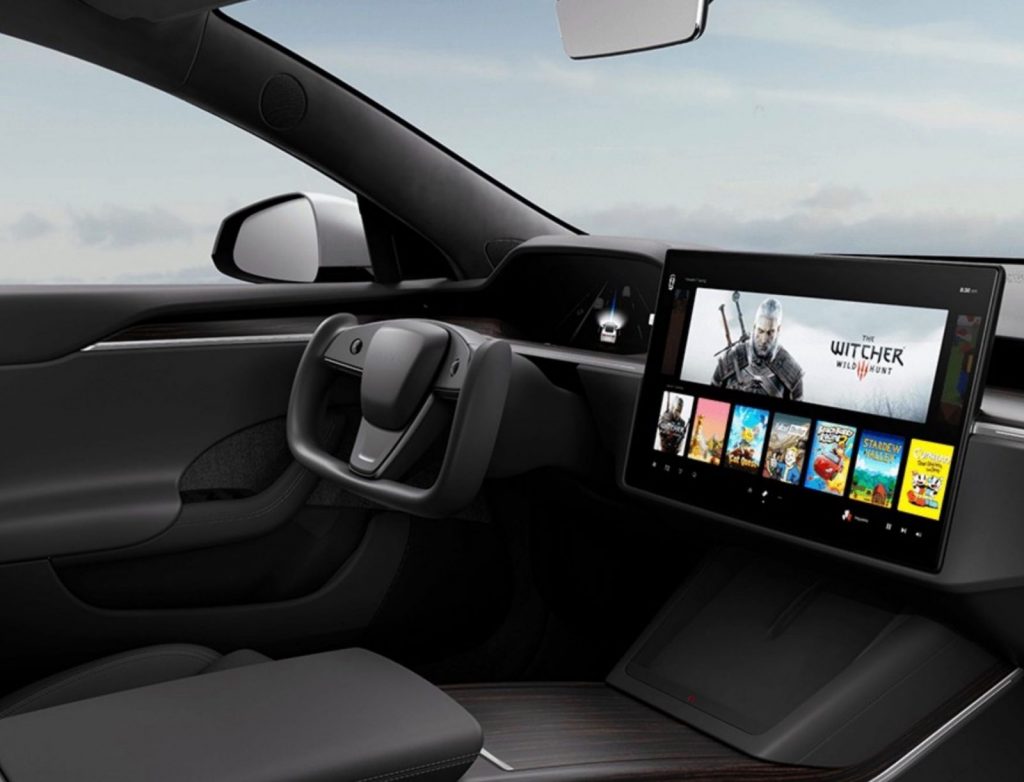
When start-up/upstart Tesla launched the Model S in 2012, it shocked carmakers and car buyers alike for its range of features that ditched convention, the most striking of which was its 17-inch portrait touchscreen. Now, almost a decade on from the car’s original launch, Tesla has caused a stir all over again by ripping up the rulebook on steering wheels.
Tesla doesn’t actually call it a wheel, instead preferring the suitably anodyne description of ‘stalkless steering yoke’, and has put the controls usually found on the stalks either on the new wheel – sorry, yoke – or within the vast touchscreen. The theory behind the wheel is that the car’s intelligent Autopilot functions will in time make a traditional steering wheel redundant, and it’s also easier to use when playing games like Witcher 3 that are accessible through the touchscreen – we kid you not. Given Tesla’s track record, and how few in 2012 thought the company would be here a year later, perhaps we shouldn’t be quite so judgemental about the ‘stalkless steering yoke’.
1973 Austin Allegro
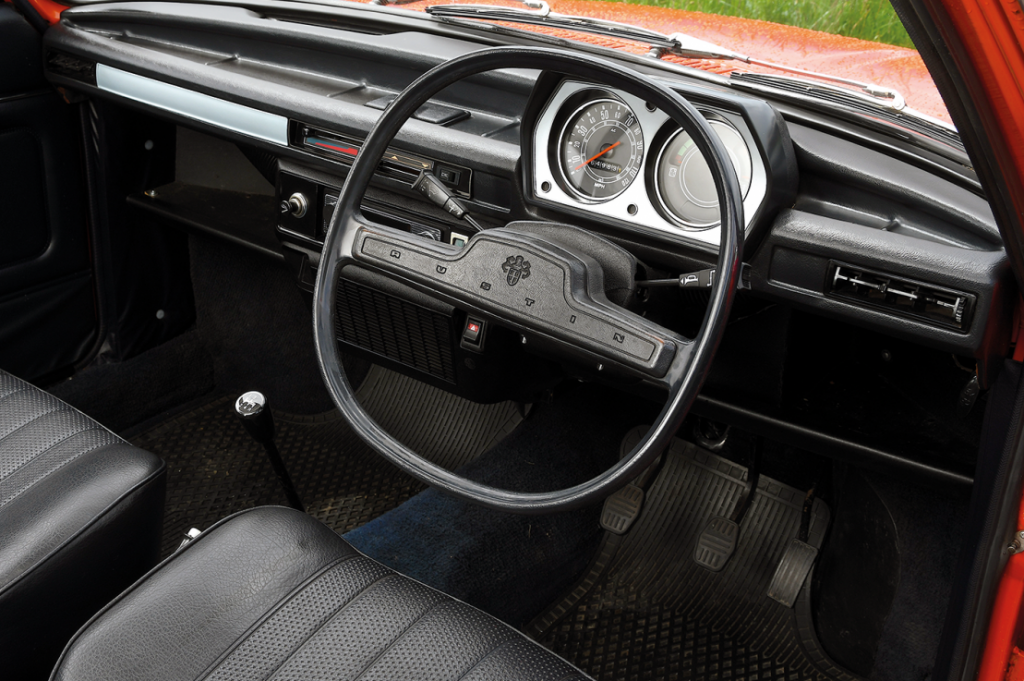
The Quartic wheel is always thrown into the mix whenever the topic of the Austin Allegro’s (long) list of faults are bandied around, with the wheel often symbolising how badly British Leyland dropped the ball with its replacement to the much-loved Austin/Morris 1100 and 1300. The Quartic’s fate was sealed right at the car’s launch in May 1973 as early road tests lampooned it – Motor famously said the Allegro’s handling was ‘marred by an unbelievable steering wheel that we all detested’. The square-ish shaped wheel was designed to make getting in and out of the car easier, but the already damage was done as by October 1973 BL quietly replaced it with the Morris Marina’s conventional round wheel. The irony is car manufacturers later adopted more square-shaped wheels for exactly the same convenience reasons, and Quartic wheels are now much sought after in the Allegro community.
1957 Citroën ID19
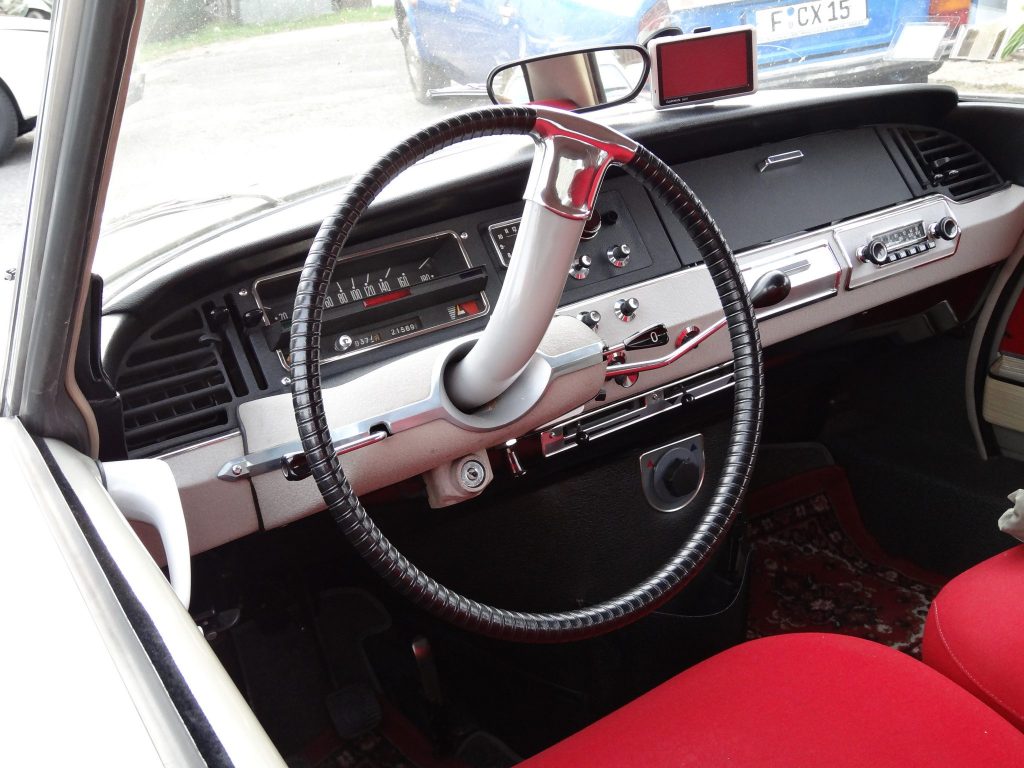
First tip of the hat goes to the one-spokers, a cohort championed by Citroen. Master of brilliantly off-beat designs, Citroën rolled out the ID 19 in 1957 to bridge the price gap between the outgoing Traction Avant and the exotic DS. The ID19 featured the same eye-catching curves as the revolutionary DS19, and boasted the same hydraulic suspension, but made do with mechanical brakes, steering, and clutch. It might not have been as innovative as the DS underneath the sheetmetal, but the ID19 was surely a full-fat interpretation of Citroën’s quirky French style. We’re especially a fan of the contrasting finishes in this one: a chrome-trimmed spoke paired with a ribbed leather rim.
1976 Aston Martin Lagonda (S2)
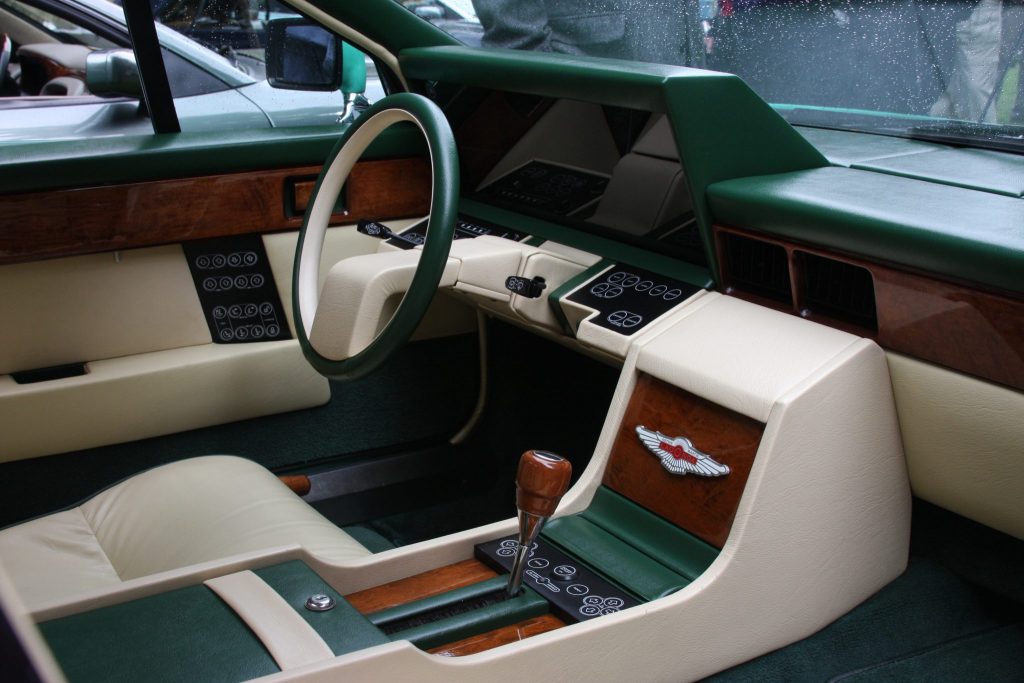
Citroën isn’t the only proud member of the one-spoke brigade. Aston Martin’s second-series Lagonda sported a less glitzy, more minimalist interpretation inside its snazzy, high-tech cabin. (After 1985, the Lagonda wheel sported a more conventional second spoke.) The 1976–85 Lagonda bucked the trend of Aston’s subtle, evolutionary design language – it looks more at home on a Bladerunner set than a sprawling country estate. The Lagonda catered to a wildly different audience than the DBS; pop stars, Arab sheiks, and the nouveau riche decked out their four-doors in eye-popping colour schemes and laughed away its 8-mpg fuel economy. Though the example above wears an understated palette, that one-spoke wheel pairs perfectly with its out-there LED screen.
1960 Plymouth Fury
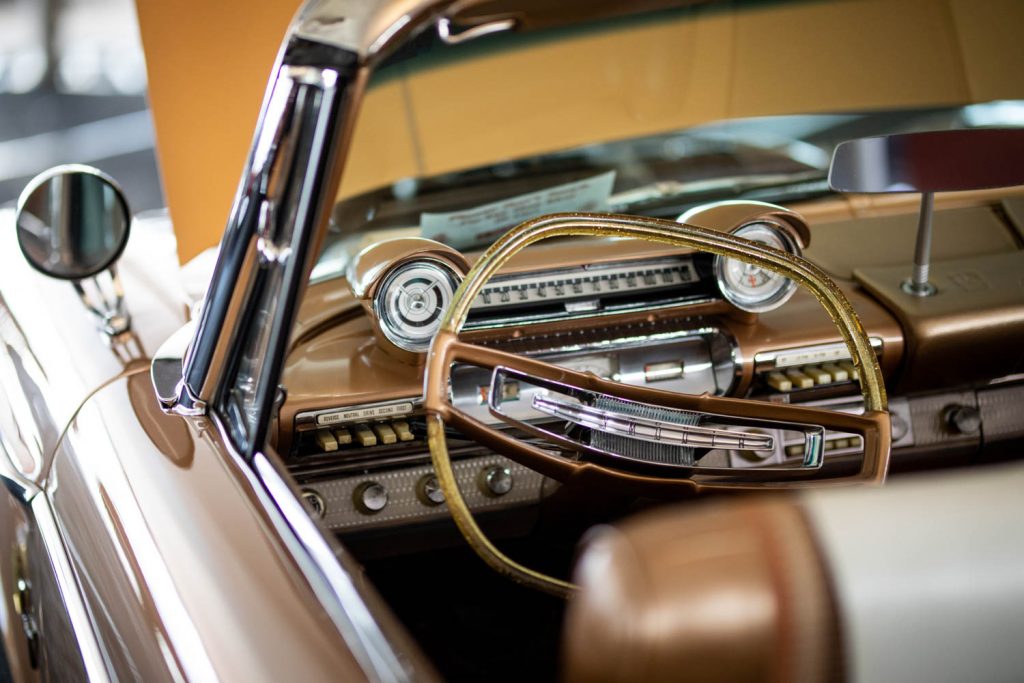
Before “fury” conjured cinematic images of nitrous-boosted Dodge Chargers and Nissan Skylines leaping in front of trains, it stood for a whole lot of fabulous. The 1960–61 Fury was the king of Plymouth’s lineup. Designers would tame the Fury’s fins and sweeping chrome eyebrows for 1961, but the 1960’s tailfins rose tall and proud, preceded by chrome eyebrows that swept from the middle of the grille over the headlights and behind the front wheels. Acres of glass, covered rear wheel wells and, of course, a loud and proud V8 motor completed the package. A car this exuberant couldn’t bear anything as pedestrian as a round steering wheel, clearly. So a hexagonal, two-spoke, gold-infused resin unit gave the dashboard a focus, like a glitter ball over a disco dancefloor.
1985 Subaru XT
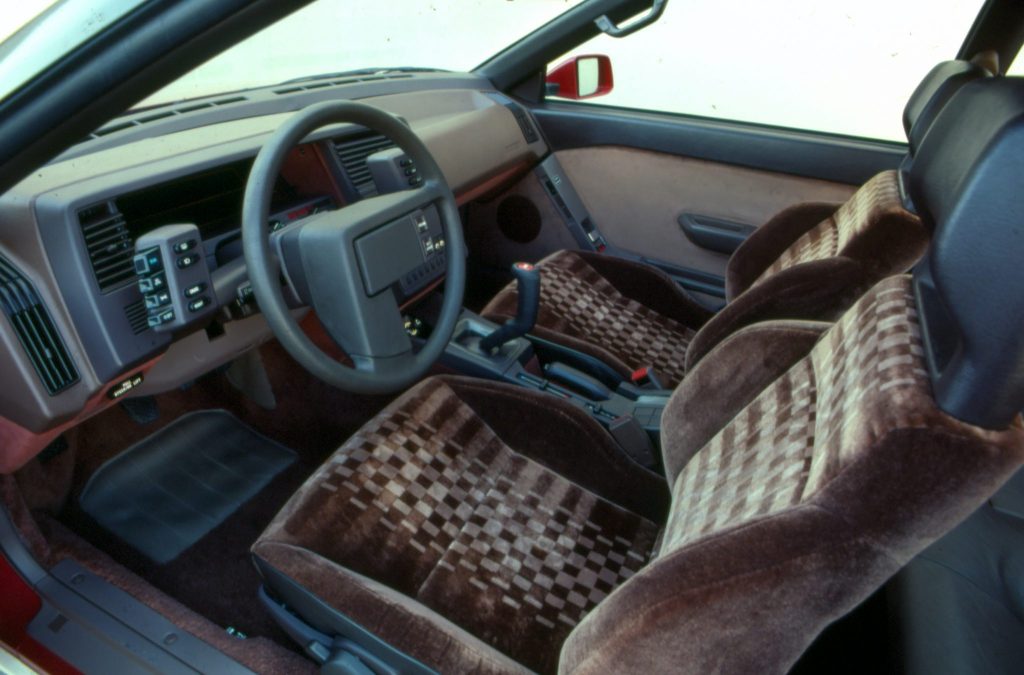
This Subaru’s steering wheel packs a bag of tricks to match its funky shape. Grab a lever to the left of the wheel under the dash, and the instrument cluster tilts along with the wheel. The cockpit set up was just one of the XT’s unconventional features, though; its incredibly slim snout and accompanying 0.29 drag coefficient were possible thanks to the compact dimensions of its overhead-cam flat-four cylinder engine. And if you were being uncharitable, the early, non-turbo models really needed that slippery profile, since they were blessed with only 97 horsepower. Turbo-equipped models were more punchy and boasted of–the–moment instrumentation that included an artificial horizon and a 3D instrument panel backlit in orange.
2000 Spyker C8 Spyder
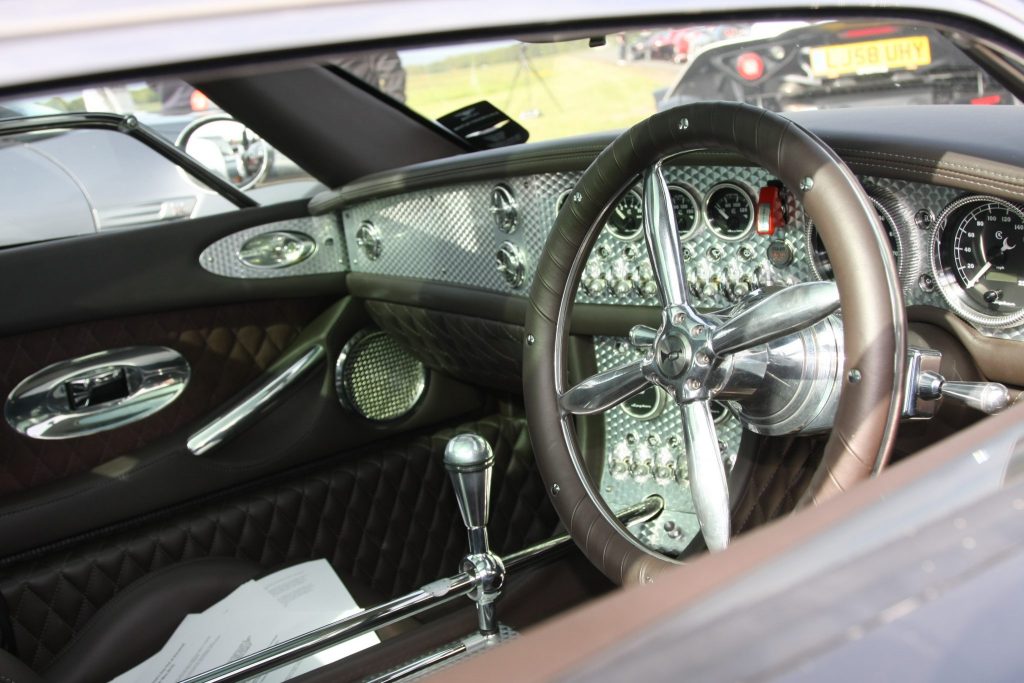
Spyker probably owns a generous swath of property in the land of flamboyant design statements. You know, if that were a thing. The Spyker name has been linked with the transportation industry since 1880, when Jacobus and Hendrik-Jan Spijker founded the company (Spijker being an alternate Dutch spelling of Spyker). They made the teak and golf-leaf Golden Coach for the Dutch royal family and, in 1903, built the Spyker 60HP race car – the first ever powered by a six-cylinder engine and also the first with a permanent four-wheel-drive system. The company didn’t stop there, extending its efforts to WWI-era biplanes as well.
It’s this glitzy, aeronautical heritage Spyker Cars sought to invoke with its first modern car, the C8 Spyder. The convertible was followed by a slew of road-legal race car iterations, fixed-roof models, and long-wheelbase versions, but the original Spyder is the king of ostentatious details with a steampunk vibe. The exposed shift linkage could only be upstaged by a truly extravagant steering wheel – in this case, one that mimics an airplane propeller. Let’s not even begin to imagine the implications of that in an accident…
1989 Pontiac Grand Prix Turbo
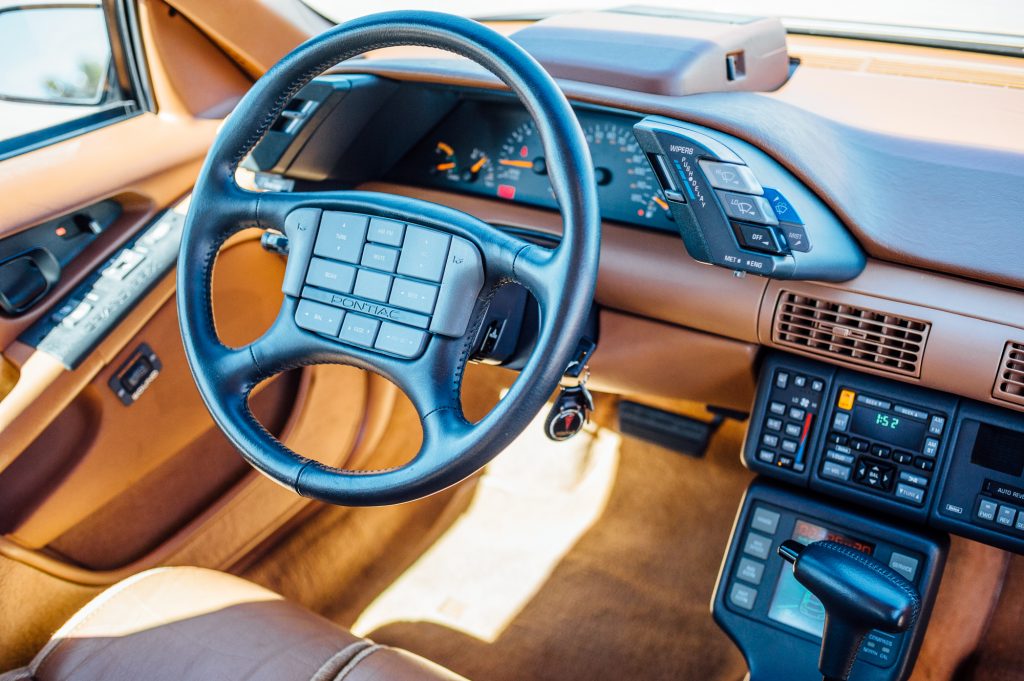
Pontiac’s 1989 Grand Prix Turbo boasted 205 hp from a turbocharged and intercooled iteration of GM’s V6, which sucked in air via a revised front bonnet and functional air ducts. But that wasn’t the most exciting part of the car; you had to sit in it to experience the really crazy stuff. There were buttons galore. The steering wheel featured 12 of them, offering you the option of controlling not only your horn, radio channel, and speaker volume, but the balance of those speakers as well. There was no airbag, either, so perhaps the final memory drivers had before any accident was their head turning the volume to max.
2021 Mercedes-AMG One
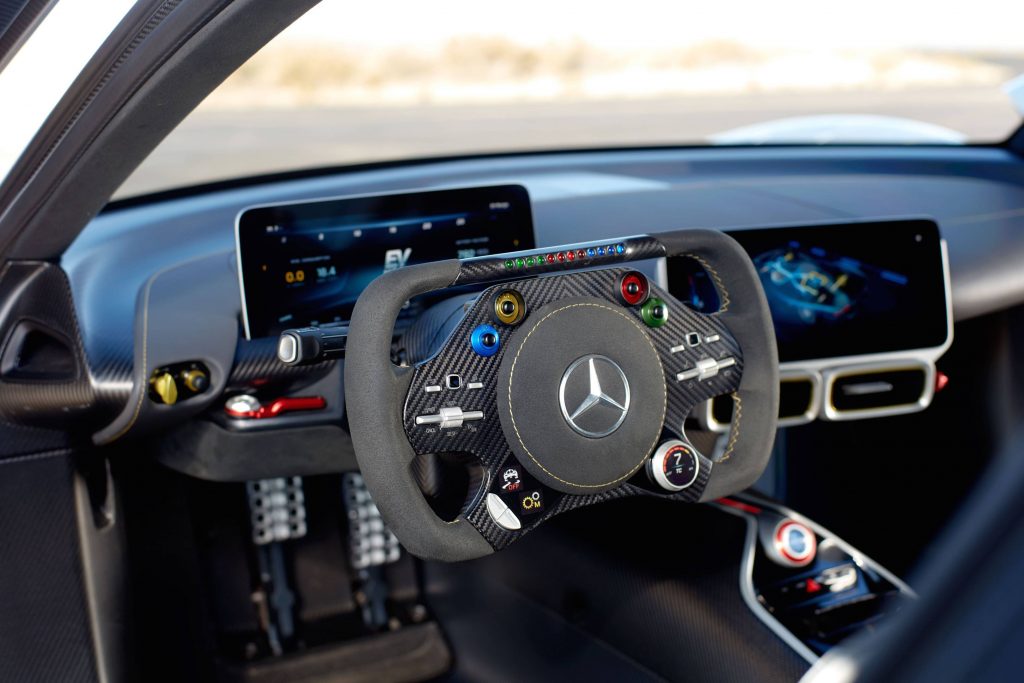
By the time the Mercedes-AMG One comes out it will be four-years old. The car was first revealed at the 2017 Frankfurt motor show, as a way of bringing F1-derived technology to the fortunate few 275 drivers (speculators?) who could afford its £2m-plus asking price. Until anyone beyond Lewis Hamilton is able to experience its hybrid powertrain, we would humbly suggest that the most interesting thing about it is the steering wheel. (The body design is generic at best, to our minds at least.) Its minimal, race-car like design features a host of controls for the traction and stability systems, gearshift and more, plus the obligatory shift-lights that all wannabe racers hanker after.
1996 TVR Cerbera
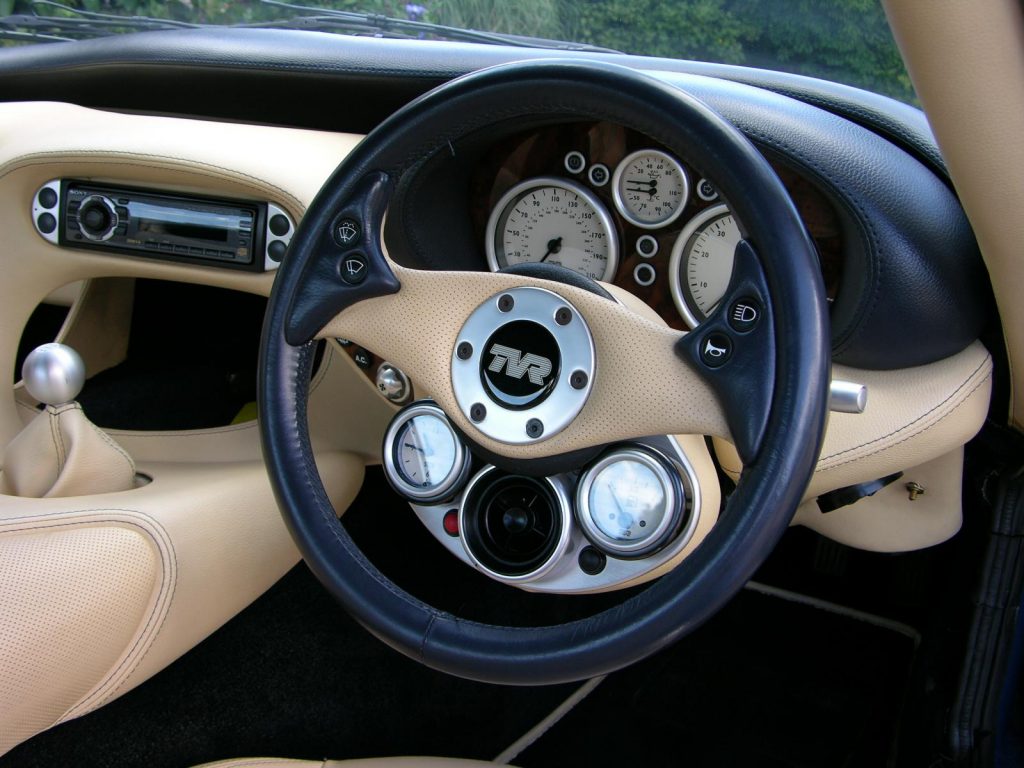
British sports car maker TVR is currently numbered among the mighty who have fallen. TVR started by building Cobra competitors, segued into a rather raunchy period in the 1970s, and rounded out the 2000s with wild-looking, big-engined beasts with mythical names: the Chimaera, Griffith, Tamora, Sagaris. The Cerbera, named after the three-headed, canine guardian of the Roman underworld, featured an alloy V8 that was built in-house – marking a high point for the small manufacturer’s ingenuity and capability. The “Speed Eight,” as the naturally aspirated 4.2-litre V-8 was called, used a flat-plane crank to produce 360 hp, a figure that rose to 440 hp in later, 4.5-litre iterations. Thankfully, engineers didn’t take the Cerbera’s triple-headed namesake too literally, but its steering wheel does have three circular insets: a clock, a fuel gauge, and an air vent, best we can tell.
1955 Messerschmitt KR200
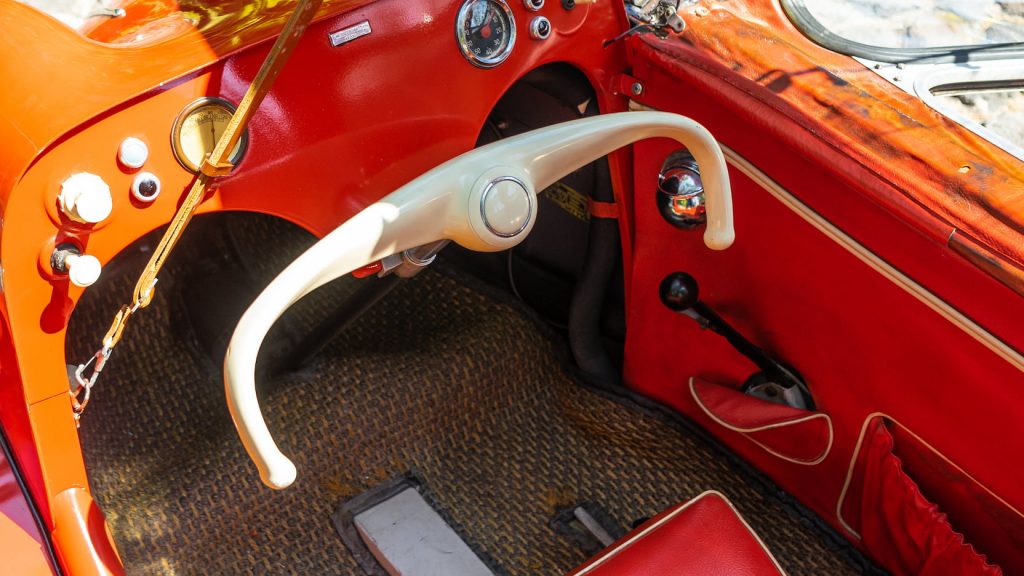
The “KR” in the name of this pop-eyed bubble car stands for Kabinenroller or “cabin scooter.” (Think “scooter with a cabin,” rather than a log building that you can drive to a lakeside campsite of your choosing.)
The KR200’s manufacturer is the same Messerschmitt that equipped the Luftwaffe during WWII with its infamous Bf 109 fighters (and their numerous variations). Messerschmitt was banned from manufacturing aircraft after the war, and so, appropriately, turned its attention to un-intimidating bubble cars. The KR200 was extremely aerodynamic, squeezing nearly 60 mph out of its 9.9-hp engine and tiny four-inch-wide tires. The aeronautical influence trickled into the KR200’s cabin, with its strange, yoke-style “wheel.” Still, it’s a more direct interpretation of aeronautical influence than the Spyker C8’s.
1949 Delahaye 135M Cabriolet by Guilloré
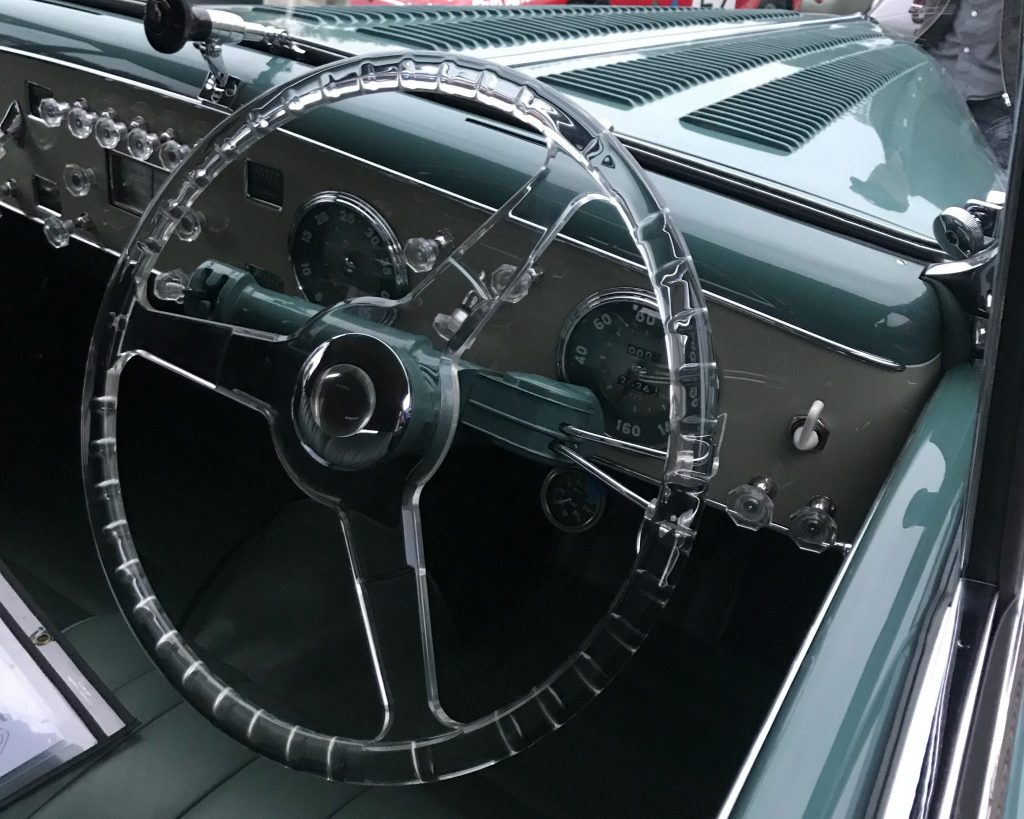
Clearly, this 1949 Delahaye – owned by Brooks Stevens, the designer of the Oscar Mayer Wienermobile – sports the winning wheel here. Before you degrade this fabulous French steering wheel by calling it “plastic,” know that the transparent material is Lucite, a trademarked brand of acrylic resin. Lucite is used as a lighter, shatter-proof alternative to glass, often in home furnishings like door handles and curtain rods. Since military applications had exhausted glass resources after WWII, Lucite enjoyed its time in the sun, and its inclusion in this coach-built cabriolet shows it was fashionable, in addition to being cheap – and safe. (Think about a glass steering wheel. Yikes.)
How Ford, Saab and Mercedes tried to steer clear of the steering wheel
We all know that the bad thing about a steering wheel is that it’s smack bang in the way of your head in the event of the most common type of accident, the frontal collision. Which is why engineers from car companies have toyed with the idea of utilising new technology to do away with one of the car’s oldest features. Ironically, such innovation sometimes bears more than a passing resemblance to the steering tiller mechanisms of the earliest motor cars.
1965 Ford Wrist Twist
When Ford first debuted the Wrist Twist, in 1965, it predicted that it would replace the steering wheel. It didn’t. Still, it gives us something to watch on YouTube, right? In place of the steering wheel came a rather complicated arrangement featuring a height-adjustable column with a small wheel on either end. The wheels turned in tandem and could be operated while your elbows were resting on an armrest. Something to do with comfort, apparently. However, the system proved twitchy and overly responsive. And dare we suggest that back in the day, the millions of drivers who smoked would not have appreciated controls so fiddly that they wouldn’t have been able to have a fag on the go?
1992 Saab 9000 Prometheus Project
Saab’s parent company built fighter jets like the Grippen, so it had extensive experience of fly-by-wire fighter aircraft. So when it ended up getting involved in a pan-European car safety programme, initiated in the 1980s, it was hardly surprising that it proposed replacing the steering wheel with a joystick. (This from a car company that put the ignition barrel between the seats of cars to reduce the risk of knee and leg injury in an accident.)
The project was called Prometheus; Programme for European Traffic with Highest Efficiency and Unprecedented Safety. Gary Axon, a Hagerty contributor, was Saab’s PR man at the time and got to try the tech for himself. “My first few faltering metres in the 9000 were an embarrassing zig-zag down the straight, over-compensating for every directional change with the joystick. However, after a surprisingly short time and distance, manoeuvring the Saab with the joystick control became totally intuitive and was a pleasurable and rewarding experience, one that today’s younger ‘joystick generation’ would feel totally at home with.”
1998 Mercedes SL Sidestick
The R129 era of Mercedes SL didn’t want for much to make it any more desirable. But engineers convinced the powers that be to let them reconfigure the soft top tourer, and do away with both pedals and steering wheel.
In their place came so-called side-sticks. First seen on the 1996 F 200 Imagination research vehicle, two levers located on either side of the driver on the centre console and in the door panel controlled the steering, acceleration and braking. It was 1980s computer gaming made real, but nobody thought to ask why anyone would want 1980s computer gaming made real. So, er, it wasn’t made real.
Has the steering wheel had its day? Or is it here to stay? Let us know what you think, in the Hagerty Community below.
Via Hagerty US

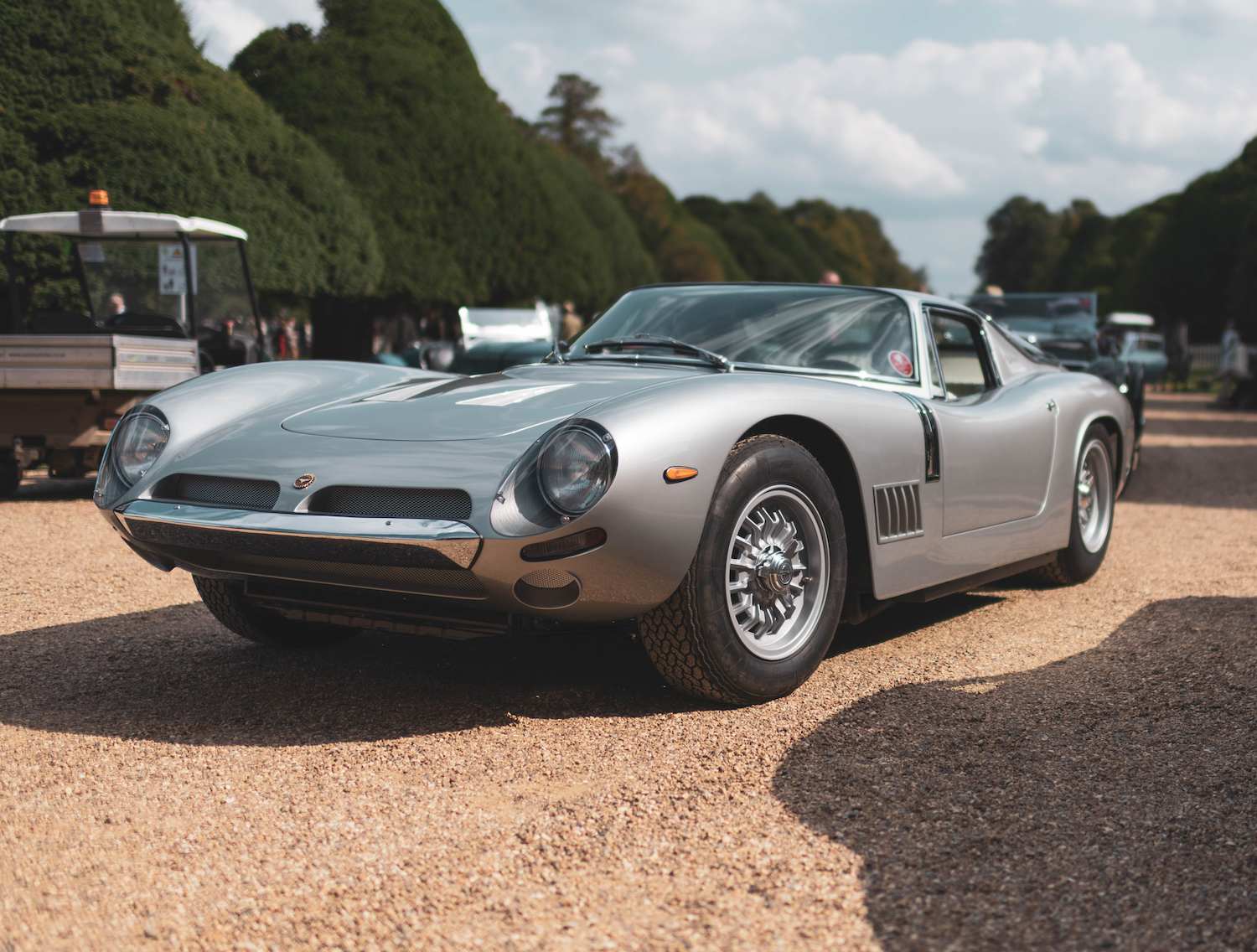

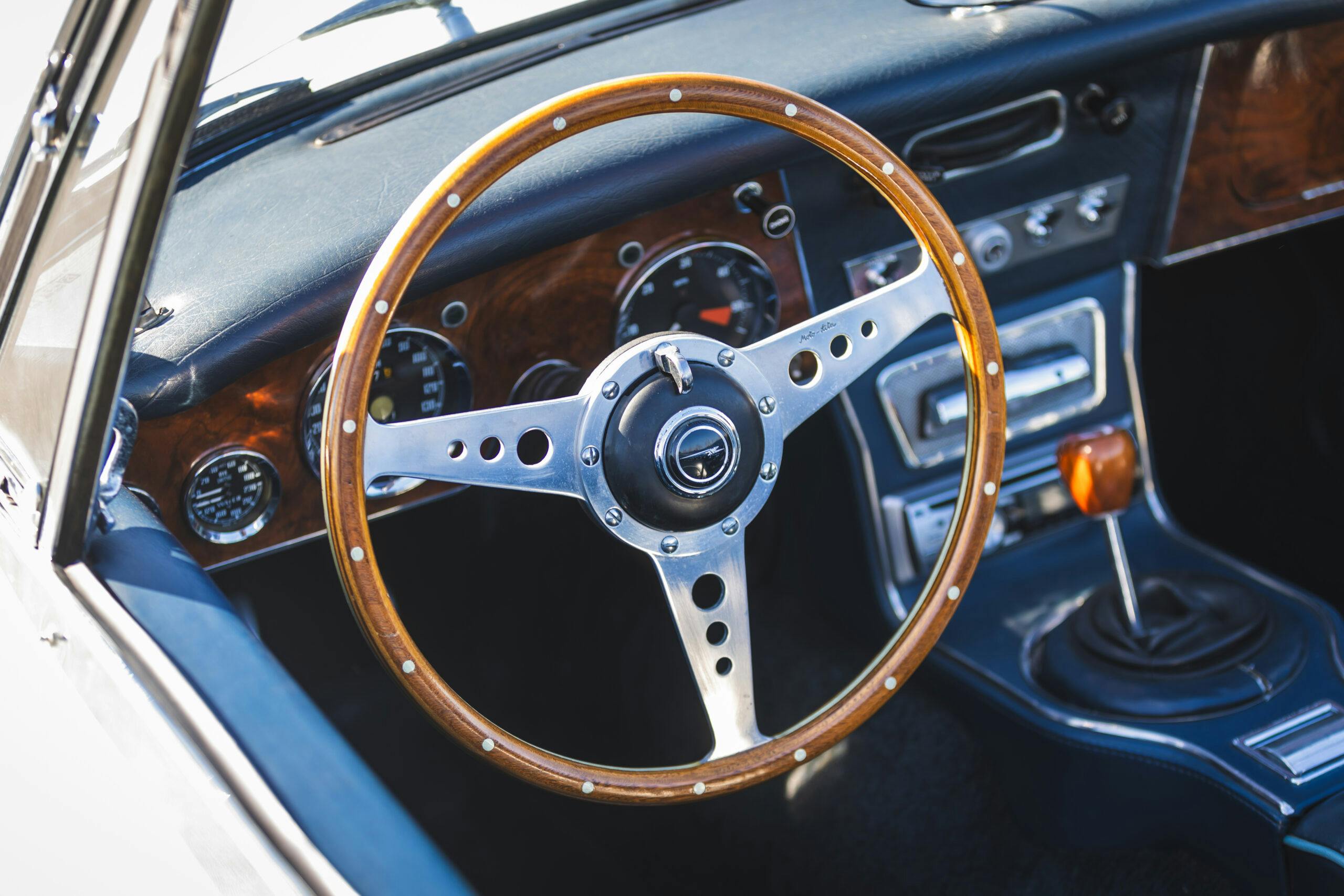






I specifically didn’t buy a Model 3 because it doesn’t have a visible/practical speedometer.
On that basis I felt it would be all too easy to lose my licence….
Why or why – from a group that can send astronauts to the space station – why can’t they make a functioning ‘heads up display?
For pure design I’ll vote for the steering control on the 1955 Messerschmitt KR200. It looks so elegant, but at the same time, presumably effective and efficient for its time? Why the need for a steering wheel at all with the development of autonomous vehicles? However, before personal semi or completely autonomous vehicles become a norm and clog up the roads even more, we should not forget that a solution is out there waiting to be developed – they are called, at the moment, taxis, buses and trains.
Nice article!
I’ve always thought that many of the engineering philosophies held by Saab were ahead of their time, and I’ve always found Citroën’s designs to be, somewhat, quirky and unconventional but also statement-making!
As a child, I loved the hydropneumatic suspension of the Citroën BX and the ‘confident look’ of the Saab 9000 CD.
Humbers built at Beeston in Nottingham used a single spoke steering wheel in the early 1900’s up to 1980. They also had an engine which rotated the opposite way compared to other cars.
My inner pedant says that the Tesla steering device should be called a yoke, not a yolk – unless it is ovoid 😉 The article gets it right with the Messerschmitt.
I grew up near Longbridge in the 70’s and many local owners of Allegros who worked there swapped the odd-looking square-ish wheel for a round one, maybe some were swapped on the sly from the Marina production line and some Marinas made it onto the road with the Allegro wheel …. ?
Great article!!! I was so pleased to see the Spyker in there……..I sat in one of these a few years ago at Le Mans when they had a C8 competing……the Spyker Squadron I think they were called!!! Avantgarde styling is probably the best description but what an amazing place to sit…….I only wish they would’ve let me take it for a spin!